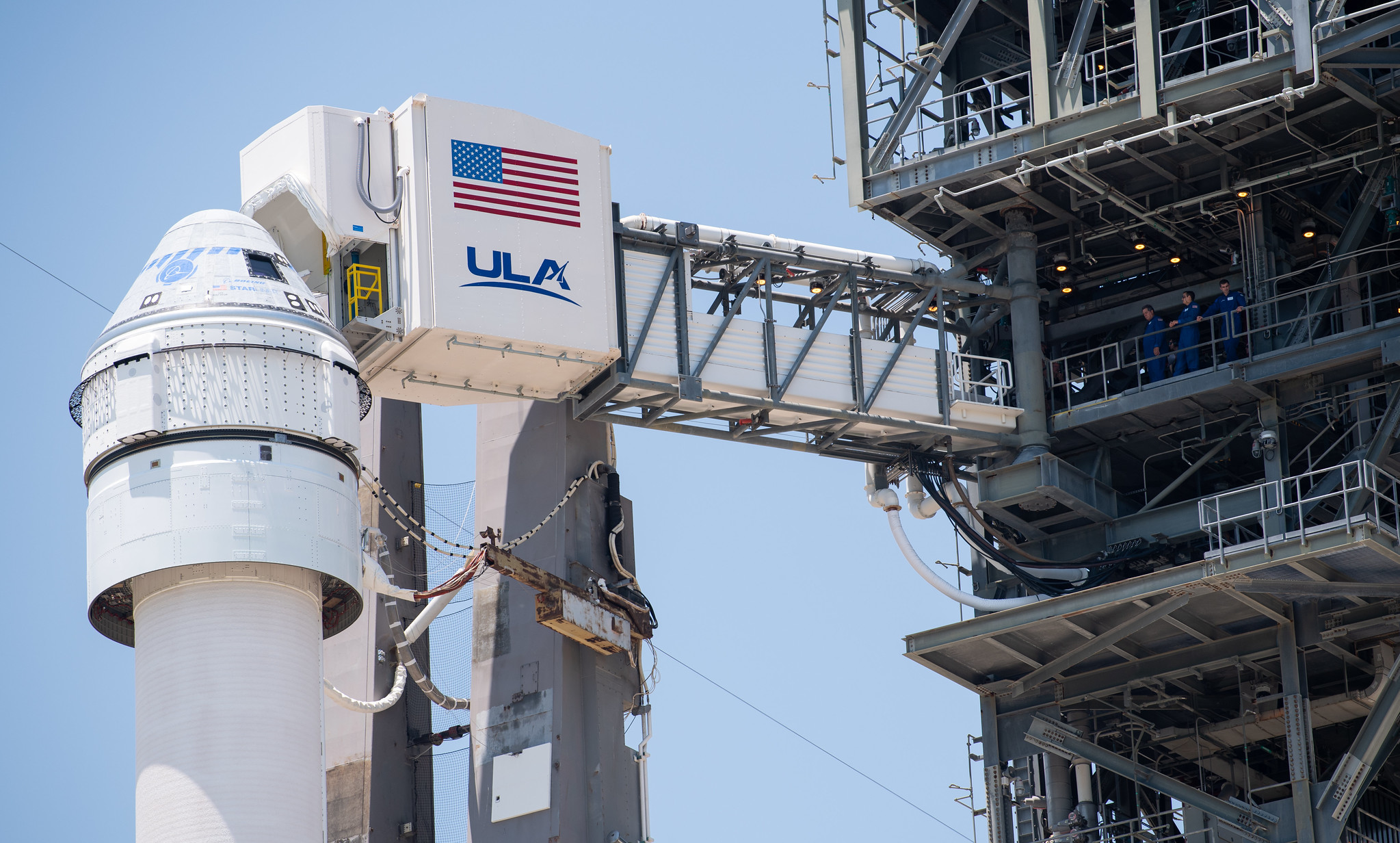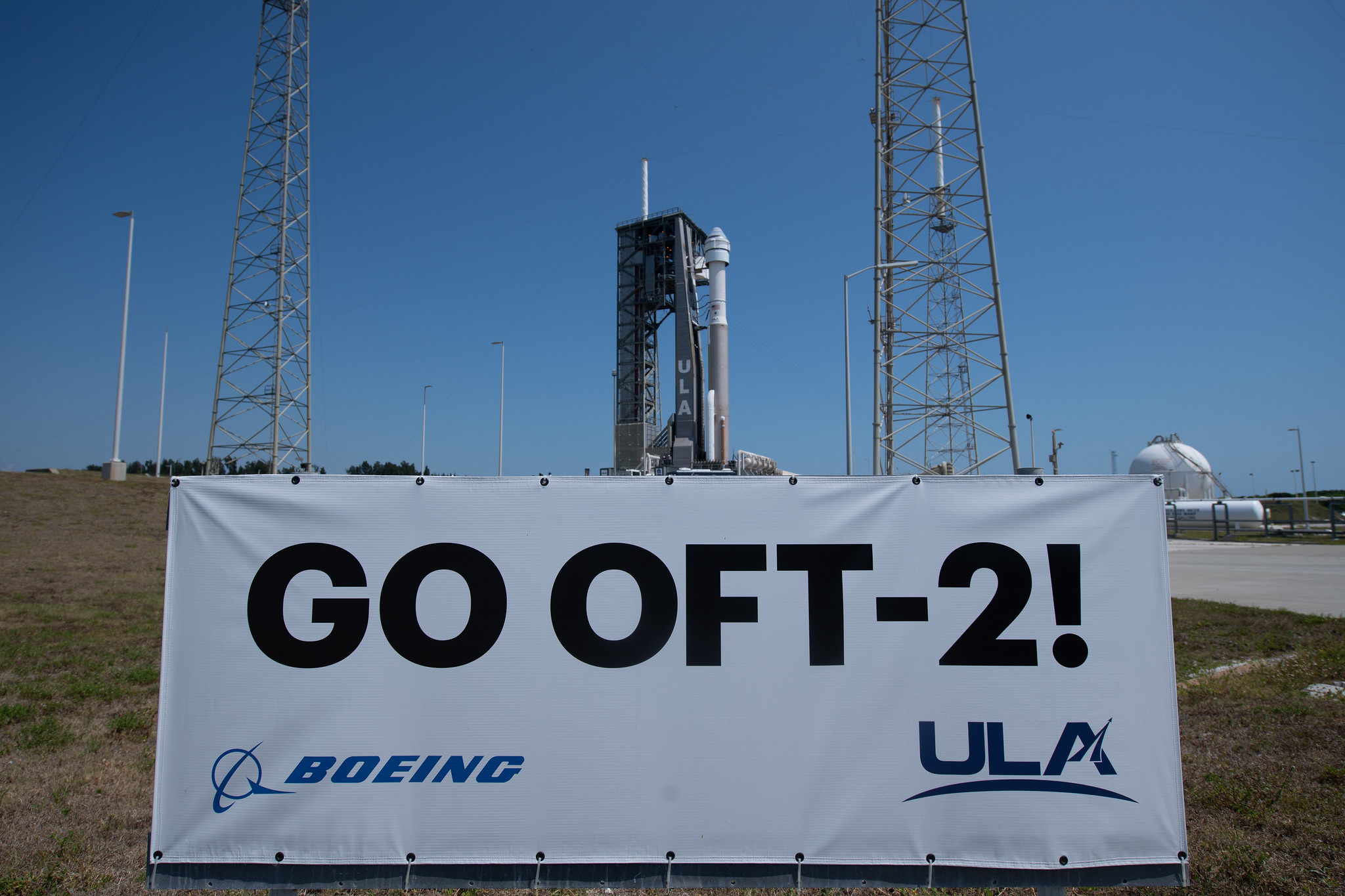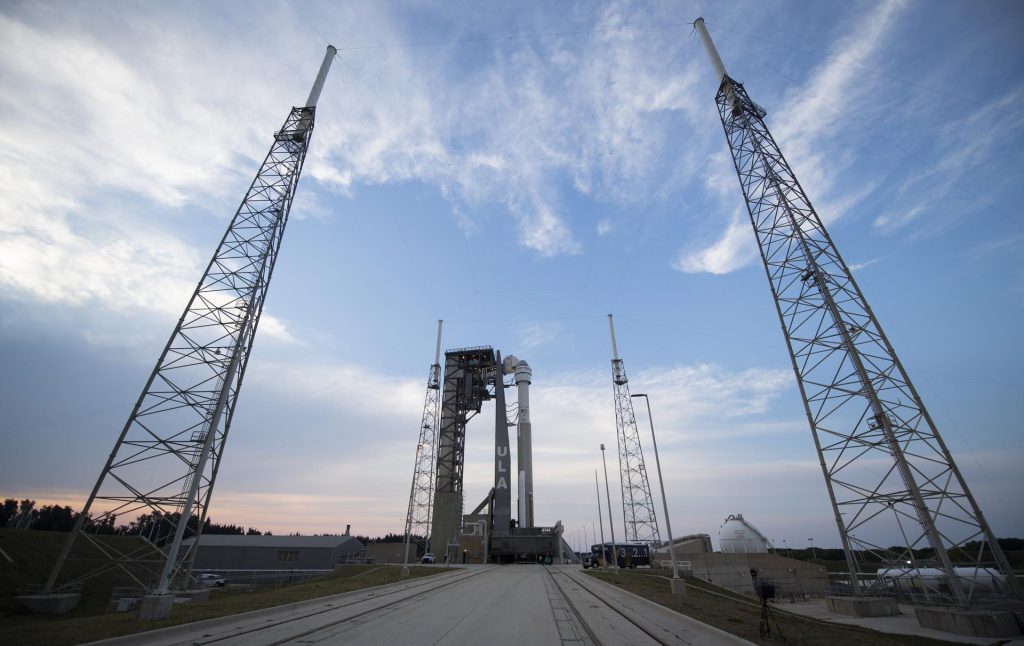The launch conductor has started a terminal count briefing with the launch team. There are three control rooms: the United Launch Alliance’s Atlas Spaceflight Operations Center on the Cape Canaveral Space Force Station; the Boeing Mission Control Center at Kennedy Space Center; and the Space Station Control Room at Johnson Space Center in Houston. NASA’s Emergency Operations Center also is activated, and United Launch Alliance has teams in Denver who will monitor ascent of the rocket.
Tag: Orbital Flight Test-2
Meet Rosie, Boeing’s First Anthropometric Starliner Commander

Though no crew will be onboard the spacecraft for NASA’s Boeing Orbital Flight Test-2, the Starliner commander’s seat will be occupied by Rosie the Rocketeer, Boeing’s anthropometric test device. During OFT-1, Rosie was outfitted with 15 sensors to collect data on what astronauts will experience during flights on Starliner. For OFT-2, spacecraft data capture ports previously connected to Rosie’s 15 sensors will be used to collect data from sensors placed along the seat pallet, which is the infrastructure that holds all the crew seats in place.
Atlas V and Boeing Starliner Remain “Go” for Launch

A United Launch Alliance Atlas V rocket with Boeing’s CST-100 Starliner atop remain “Go” for launch from Space Launch Complex-41 at the Cape. Starliner’s destination is the International Space Station on its second flight for NASA’s Commercial Crew Program.
Teams Cleared the White Room at the Launch Pad

The combined White Room Crew of Boeing and United Launch Alliance have closed and secured the white room, performed cabin leak checks of the CST-100 Starliner and cleared the white room. The team has cleared the crew access tower and driven to a safe distance from the launch pad.
Meteorologists with the U.S. Air Force 45th Weather Squadron now predict a 90% chance of favorable weather for launch this afternoon.
The Atlas V Rocket for Boeing’s CST-100 Starliner Launch
United Launch Alliance’s Atlas V rocket that will launch Boeing’s CST-100 Starliner to the International Space Station for NASA’s Commercial Crew Program was modified specifically for the agency’s Orbital Flight Test-2. This rocket configuration does not include a payload fairing. Instead, the Starliner’s own protective surfaces will take the place of the fairing to protect the uncrewed spacecraft during launch and ascent. The rocket has two solid rocket boosters (SRBs) and a dual-engine Centaur upper stage. Starliner is attached to the Atlas V using a launch vehicle adapter, which includes an aeroskirt to reduce the aerodynamic loads on the vehicle.
The Atlas V booster is 12.5 feet in diameter and 106.5 feet in length. The booster’s propulsion is provided by the RD-180 engine system, which delivers 860,200 pounds of thrust at sea level. The SRBs generate the additional power required at liftoff, with each providing 348,500 pounds of thrust.
The Centaur second stage is 10 feet in diameter and 41.5 feet in length. For this configuration, the Centaur is configured with dual RL10A-4-2 engines, each producing 22,600 pounds of thrust. The cryogenic tanks are insulated with a combination of helium-purge blankets, radiation shields, and spray-on foam insulation. The Centaur includes an Emergency Detection System that monitors for critical hazards. This system will provide critical in-flight data which supports jettison of the ascent cover and initiates CST-100 spacecraft separation.
Learn more at www.ulalaunch.com.
Boeing’s CST-100 Starliner Spacecraft

NASA’s Boeing Orbital Flight Test-2 will provide valuable data that will help the agency certify the company’s CST-100 Starliner spacecraft to carry astronauts to and from the International Space Station for NASA’s Commercial Crew Program. Starliner is designed to accommodate up to seven passengers or a mix of crew and cargo, but for NASA missions will carry up to four astronauts to the orbiting laboratory.
Starliner’s two main segments are the crew module and service module and together they are 16.5 feet high and 15 feet in diameter. The crew module is intended to be reused for up to 10 missions.
For orbital maneuvering and attitude control of Starliner, a total of 20 engines can each produce 1,400 pounds of thrust and, together, provide the spacecraft with the propulsion it needs to reach orbit after separating from United Launch Alliance’s Atlas V rocket. A combined 28 reaction control system engines, each providing 85 pounds of thrust, will provide the velocity needed for Starliner to make small directional changes, including when it docks to the space station. The spacecraft also is equipped with four launch abort engines to be used during an unlikely abort scenario.
Starliner is designed to land at one of five landing sites in the continental U.S. Learn more at www.boeing.com/Starliner.
Boeing’s Orbital Flight Test-2 Objectives

NASA’s Boeing Orbital Flight Test-2 will test the end-to-end capabilities of the company’s CST-100 Starliner spacecraft from launch to docking to a return to Earth in the desert of the western United States. The flight test will provide valuable data toward NASA certifying Boeing’s crew transportation system for regular crewed flights to and from the International Space Station. OFT-2 will build on the objectives achieved during Starliner’s initial flight test, including:
- In-orbit operation of the avionics, docking system, communications and telemetry systems, environmental control systems, solar arrays and electrical power systems and propulsion systems;
- Performance of the guidance, navigation and control systems of the Starliner and Atlas V through ascent, on-orbit, and entry;
- Acoustic and vibration levels, and loads across the Starliner exterior and interior;
- Launch escape trigger monitoring; and
- Performance of the Starliner system end-to-end mission operations.
These objectives are intended to demonstrate all of Starliner’s systems and capabilities except for those requiring a human onboard to test.
For this flight, Starliner will carry more than 500 pounds of NASA cargo and crew supplies to the space station. After a successful docking, the spacecraft will spend five to 10 days aboard the orbiting laboratory before returning to Earth. The spacecraft will return with nearly 600 pounds of NASA cargo, including reusable Nitrogen Oxygen Recharge System tanks that provide breathable air to station crew members.
Read more about OFT-2.
Live Coverage Begins for NASA and Boeing’s Orbital Flight Test-2

Good afternoon from Kennedy Space Center in Florida, and welcome to live launch coverage of NASA’s Boeing Orbital Flight Test-2 (OFT-2) to the International Space Station, launching in a little over an hour. Boeing’s CST-100 Starliner spacecraft sits atop a United Launch Alliance Atlas V rocket poised on the launch pad ready to go at nearby Space Launch Complex-41 on Cape Canaveral Space Force Station.
OFT-2 is an uncrewed flight test of the company’s Starliner spacecraft for NASA’s Commercial Crew Program. Liftoff is scheduled for 6:54 p.m. EDT during an instantaneous launch window.
The countdown is currently proceeding according to schedule. Fueling of the Atlas V rocket began a little after noon EDT today. The first stage booster’s RD-180 engine, containing two thrust chambers, was fueled with Rocket Propellant-1, a highly purified kerosene. The Centaur second stage was fueled with liquid hydrogen and liquid oxygen. Fueling of the rocket was completed about two hours later.
Stay with us here for coverage as the countdown continues towards launch. Watch the coverage live on NASA TV starting at 6 p.m. EDT. More details about the flight test and NASA’s Commercial Crew Program can be found in the online press kit and by following the @commercial_crew on Twitter and commercial crew on Facebook.
Meteorologists with the U.S. Air Force 45th Weather Squadron continue to predict an 80% chance of favorable weather for launch this afternoon. The primary concerns for launch day are the cumulus and anvil cloud rules violations during the instantaneous launch window.
Weather Forecast Improves for Today’s OFT-2 Launch

Meteorologists with the U.S. Space Force 45th Weather Squadron now predict an 80% chance of favorable weather for today’s uncrewed launch of NASA’s Boeing Orbital Flight Test-2 (OFT-2) to the International Space Station. Liftoff is scheduled for 6:54 p.m. EDT from Cape Canaveral Space Force Station in Florida.
The primary weather concerns for launch day are the cumulus and anvil cloud rules violations during the instantaneous launch window.
Boeing’s CST-100 Starliner spacecraft, atop a United Launch Alliance Atlas V rocket, will lift off from Space Launch Complex-41. Live launch coverage begins at 6 p.m. EDT on NASA TV, the NASA app, and the agency’s website.
Orbital Flight Test-2 Starliner, Atlas V Roll to Pad, NASA Leaders to Brief Media

This morning, Wednesday, May 18, Boeing’s CST-100 Starliner spacecraft and the United Launch Alliance (ULA) Atlas V rocket rolled out of the ULA Vertical Integration Facility to the launch pad at Space Launch Complex-41 on Cape Canaveral Space Force Station in Florida ahead of the uncrewed launch of NASA’s Boeing Orbital Flight Test-2 (OFT-2) to the International Space Station. Liftoff is scheduled for 6:54 p.m. EDT on Thursday, May 19.
For a launch Thursday, meteorologists with the U.S. Space Force 45th Weather Squadron continue to predict a 70% chance of favorable weather. The primary weather concerns for launch day are the cumulus and anvil cloud rules violations during the instantaneous launch window.
NASA leaders will update members of the news media on OFT-2 during a briefing on Wednesday, May 18, at 1 p.m. The briefing will air live on NASA TV, the NASA app, and the agency’s website. Participants include:
- Bob Cabana, NASA associate administrator
- Janet Petro, director, NASA’s Kennedy Space Center
- Kathryn Lueders, associate administrator, Space Operations Mission Directorate at NASA
- NASA astronaut Suni Williams
- NASA astronaut Butch Wilmore
- NASA astronaut Mike Fincke
NASA TV will cover the upcoming prelaunch, launch, and docking activities. Mission coverage is as follows (all times Eastern):
Thursday, May 19
6 p.m. – NASA TV launch coverage begins for a targeted 6:54 p.m. liftoff. NASA TV will have continuous coverage through Starliner orbital insertion.
9 p.m. (approximately) – Postlaunch news conference on NASA TV
Friday, May 20
3:30 p.m. – NASA TV rendezvous and docking coverage begins.
7:10 p.m. (approximately) – Docking
Friday, May 21
11:30 a.m. – NASA TV hatch opening coverage begins
11:45 a.m. – (approximately) Hatch opening and welcoming remarks
Learn more about station activities by following @space_station and @ISS_Research on Twitter as well as the ISS Facebook and ISS Instagram accounts.
